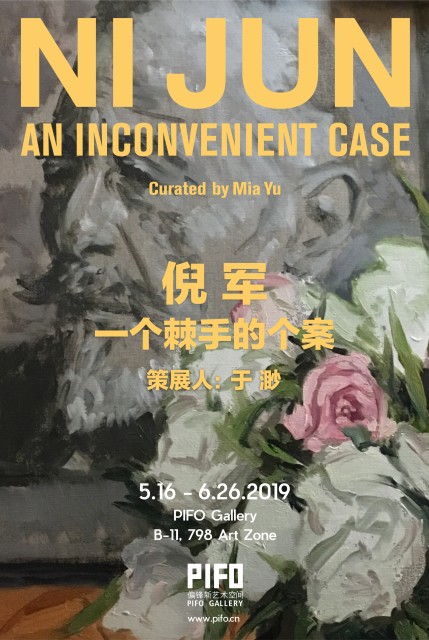PIFO Gallery presents Ni Jun’s solo exhibition Ni Jun: An Inconvenient Case curated by art historian Mia Yu. Spanning over forty years, Ni Jun’s extraordinary career cannot be conveniently framed within any single narrative. By presenting important works and archives from different stages of Ni’s career, the exhibition attempts to situate the artist’s oeuvre in the intersections and entanglements of art historical and personal trajectories. The exhibition not only aims at presenting the complexities of Ni Jun’s works, but also using Ni Jun as a case study to question the unifocal, Western-centric narrative of ‘the contemporary’.
-----------------------------------------------
Born in 1963, Ni Jun entered the high school attached to Central Academy of Fine Arts in Beijing to study art, as one of the first students being admitted after the Cultural Revolution. Upon graduation, Ni Jun continued to study at Central Academy of Arts and Crafts with prominent modern painters such as Yuan Yunfu. The academic training that Ni Jun received was derived from the Socialist Realist tradition and afforded him with solid skills as a realist painter. In 1989, after showing an abstract work at the now iconic “China Avant-garde Exhibition”, Ni Jun moved to the U.S. to study at Rutgers University. New York in the early 1990s witnessed a thriving art community with Chinese artists including Chen Danqing, Ai Weiwei, Ma Kelu, Xu Bing and Chen Yifei. As one of the most active members in this community, Ni Jun curated numerous exhibitions for his artist friends, founded an artist community newspaper called OIPCA Quarterly and even made several films casting Chinese artists as lead characters. While travelling all over to see Western modern and contemporary art, he was increasingly troubled by the Euro-American art history as the dominating reference to understand the non-Western art. Upon returning to China in 2001, Ni Jun shifted his focus to study the pioneers of Chinese modern art, including Zhu Qizhan (1892-1996), Wu Zuoren (1908-1997), Dong Xiwen (1914-1973), Tang Xiaoming (1939-) and his teacher Yuan Yunfu (1933-2017). He also drew divergent inspirations from the 19th-century painters such as Édouard Manet, Camille Corot and Gustave Courbet, as well as the Song-dynasty painting.
As art historian Mia Yu commented, “Ni Jun’s transcultural trajectory over the last forty years manifested the complexities inherent in the relationships between the Chinese art and the global art history. Ni Jun’s career is parallel to the development of Chinese contemporary art, and yet he has missed out on all the important events partly due to being abroad; Ni Jun has close friendships with many important artists and curators, and yet he never participated in any milestone group shows; while in the U.S., Ni Jun studied with the most prominent contemporary painters in order to ‘unlearn’ what he has learned at the Chinese art academy, and yet he later consciously returned to Chinese modern art for a renewed self-education; Ni Jun acquainted himself with all sorts of contemporary art, and yet he keeps a critical distance from the current trends and maintains a fervent devotion to painting. Ni Jun grew to become an artist at the end of the rupture-filled 20th century. Socialist Realism is deeply ingrained in his art education, a historical legacy that Ni has inherited from the 20th century Chinese modern art. Ni Jun never discards this legacy; instead that he treasures it until today. Ni Jun consciously revitalizes the painterly quality unique to the Chinese modern painting, at the same time tries to synthesize the essences of the 19th-century Realist painting and the Song-dynasty painting. Ni Jun’s oeuvre, being constituted by multiple and entangled art histories and epistemologies, opens ‘the contemporary’ as a terrain of contestation, energized by specific local, national and global contingencies. As an artist who cannot be conveniently categorized, Ni Jun prompts us to question the unifocal, Western-centric narrative of ‘the contemporary’. It is precisely such ‘inconvenience’ that makes Ni Jun an invaluable case study.”
The exhibition “Ni Jun: An Inconvenient Case” opens on May 16 and lasts until June 26.
-----------------------------------------------
Ni Jun, born in1963, Tianjin. He received his Master Degree from Rutgers University in New Jersey and settled in New York in 1991. Currently lives and works in Beijing.Ni Jun as the first students of the high school attached of CAFA after the Cultural Revolution. After studying with Yuan Yunfu in Central Academy of Arts and Crafts, he studied at the Mason Gross School of the Arts at Rutgers University with Leon Goleb in the U.S., in 1993 founded an artist community newspaper called OIPCA Quarterly. He has many solo exhibitions, gives lectures in art academies in China and the U.S. over the years. His works are kept in The Huntington Library, Los Angeles; CAFA Art Museum, Beijing; Tsinghua University Art Museum, Beijing; Guangdong Art Museum, Guangzhou; Long Museum, Shanghai; Yuan Art Museum, Beijing; Pingshan Art Museum, Shenzhen; POLY Art Museum, Beijing and private collections all over the world.
-----------------------------------------------
Curated by Mia Yu, Beijing

